Calcutta

Introduction
Calcutta is interesting because, on the one hand, it has a key character that is very much in sync with its year of release, and, on the other hand, it has characters and a plot that go against the grain.
Main Credits
Director: John Farrow. Writer: Seton I. Miller. Producer: Ben Stoloff. Cinematographer: Jack MacKenzie. Music: Roy Webb. Art Directors: Franz Bachelin, Hans Dreier. Editor: Archie Marshek. Cast: Alan Ladd (Neale Gordon), Gail Russell (Virginia Moore), William Bendix (Pedro Blake), June Duprez (Marina Tanev), Lowell Gilmore (Eric Lasser), John Whitney (Bill Cunningham). Released: Paramount Pictures, August 29, 1947. 83 minutes.
Presentation
Michael F. Keaney’s Film Noir Guide: 745 Films of the Classic Era, 1940-1959 (McFarland & Company, Inc., 2003) has the following plot summary of Calcutta.
“When their buddy Whitney is strangled in a barroom brawl, commercial pilots Ladd and Bendix go looking for payback. They find themselves involved with Whitney’s mysterious fiancée (Russell), the owner of a gambling casino (Gilmore), some nasty jewel smugglers and the British police, who suspect them of having committed a murder. Duprez plays a worried nightclub singer, who is afraid that boyfriend Ladd may be falling for the beautiful Russell.” (73)
Calcutta is representative of its time because the most significant year of the femme fatale in film noir is 1947, as shown not only in the frequency but also the variety of ways she appears. The character is principally associated with hardboiled film noir. In this year Out of the Past was released and, of all hardboiled film noirs, it has perhaps the most celebrated femme fatale, Jane Greer’s Kathy Moffat.
Although Alfred Hitchcock may be an exemplar of the auteur, nonetheless the same changes occur to the important female characters in his films, from 1942-1947, as in those of other directors. During the early war years, a woman with a job often helps a hunted man prove his innocence. In 1942, Hitchcock made Saboteur. By the end of the war and in postwar years, the woman who can take charge changes to the woman in distress. In 1946, he made Notorious. And he made The Paradine Case, with Alida Valli as the femme fatale, in 1947.
Even if Calcutta doesn’t stand out in 1947 by having a femme fatale, the puzzle in its plot makes it a very unusual postwar film noir.
After 1945, those who are guilty are known, so there’s no mystery to solve. However, during WWII, puzzles were frequent. Similar to the whodunit film noirs released during WWII, in Calcutta those who solve the crime are civilians, not the official constabulary (in this case, the British police). Typically, in postwar film noirs, state and federal law enforcement capture or kill the criminal, and local police play no role.
Whatever one’s view of Gail Russell’s acting performance, her character occupies a distinctive place among femme fatales in American film noir. First, precisely because Calcutta is a puzzle, the audience doesn’t know Russell is a femme fatale until the end. This is completely different from the audience’s awareness of the danger to men posed by a legion of postwar femme fatales, such as Ava Gardner in The Killers (1946), Rita Hayworth in The Lady from Shanghai (1948) and Barbara Stanwyck in The File on Thelma Jordan (1950), to name a few of the most (in)famous.
Second, Russell, unlike Mary Astor in the WWII whodunit, The Maltese Falcon (1941), doesn’t kill a stranger (a private eye) without being too sure why she did so. Instead, Russell has her fiancé murdered. Then, after murdering someone else herself, she is ready to kill once more, and the victim would again be a man she’s in love with. Gail Russell is an extremely special kind of femme fatale!
A final way Calcutta is atypical is that the ending doesn’t create a romantic couple. While we watch the film, it would be fair to think that Alan Ladd will give up his independent lifestyle and settle down with June Duprez. After all, we see that he can fall for a woman. Therefore, once he has learned his lesson with Russell, we could think that he will recognize that the right woman has been there all along, and he will show Duprez how much he cares for her. But that doesn’t happen.
Calcutta ends just as it begins, with Duprez and Ladd’s relationship just as it was – she is devoted, and he is uncommitted. What will happen between Ladd and Duprez in the future is anyone’s guess. But I certainly like a final scene that leaves things ambiguous, instead of assuring us that a walk down the aisle to an altar is certain to occur.